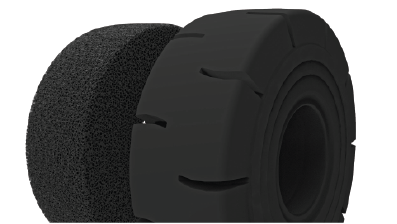
Article by
Are you trying to find a solution to improve the performance of your tires? The good news is that you don't have to get the best tires and keep replacing them for thousands of dollars. Simply filling them with foam is all that is necessary. The extra work is apparently worth it, because foam-filled tires come with special benefits and capabilities that companies are willing to pay thousands of dollars more than conventional air-filled tires. So, how exactly are foam-filled tires made, and what makes them so expensive?
Foam-filled tires are basically the exact same thing as air tires. They just have a heavy-duty compound called urethane in them that gets injected through a hose. You ever let it sit over three to four days, and that’s called the curing process.
Once the liquid urethane has hardened and manufacturers are sure that the tire is absent of any air, they are ready to go. So, what’s the point of having your tires filled with dense foam instead of air? If you have a construction company working on a site covered in loose nails and debris, foam-filled tires that cannot go flat are exactly what you need.
The companies will usually do foam-filled tires if they don’t want any downtime, because downtime is very expensive for certain customers. Basically, what downtime means is if you get a flat because you have an air tire, then you are unable to move that unit. A tire guy comes along and fixes it.
Besides being impervious to punctures, foam-filled tires provide construction trucks with a softer ride because of the consistent PSI in each tire, and they add extra weight for the more difficult tasks. Foam-filled tires can also act as ballast. So, basically, if you are lifting really heavy things, like heavy rocks, it can stop you from tilting forward or if you’re rolling the big rollers, you put on foam-filled tires, and it adds maybe 1000 to 2000 pounds, even more depending on the tire size.
But don’t get confused. These tires are not made for your full-size pickup or off-road SUV. The speed of passenger vehicles would make the foam melt, and the weight of the tires alone could send you veering off the road and destroy your suspension.
There’s a lot of controversy between if something on the highway can actually have foam-filled tires? A lot of people ask, “Can they put foam-filled tires on their cars?” and it’s definitely a no. Typically foam-filled tires are used for low-speed vehicles like construction units, like a skid steer or a loader.
Still, it’s hard not to envy the idea of tires that can’t go flat. That’s why the construction companies that use them have to pay so much, between the amounts of labor and liquid urethane filling they involve. So, you’re usually going to have to pay two or three times more per tire. And you also have to purchase a new tire as soon as you want foam, because if you start to put a used tire on, it doesn’t really make the cost worth it. So, if it's about a smaller tire, it would usually be worth up to $1,000 per tire. And then for the higher-end tires, like the big mining trucks you see in the quarries, it’s going to be upwards of $5000 to $10000 per tire.
These extra-expensive construction tires last the same amount of time as regular air-filled ones, if not longer, before their tread wears off. Even so, the time eventually comes when foam-filled tires need to be disassembled. Videos of tire technicians tearing them apart and at the end of their life span have become popular online, but that fun-to-watch process is not the typical way it’s done.
The people that foam-fill the tires can take it off with a machine, which is way easier and also saves a ton of time. But it can actually be done manually and it’s really labor intensive. The reason why it’s done manually is because it saves the customers a couple of hundred dollars here and there. Maybe for four tires, it would cost $500 or $600. And instead, it will charge the customers $250.
 Monthly "Azeem English Magazine", launched in 2000, records the information about diverse fields like mental health, literature, research, science, and art. The magazine's objective is to impart social, cultural, and literary values to society.
Monthly "Azeem English Magazine", launched in 2000, records the information about diverse fields like mental health, literature, research, science, and art. The magazine's objective is to impart social, cultural, and literary values to society.
+92 51 88 93 092
First Floor, RAS Arcade, Eidhi Market, Street#124, G-13/4, Islamabad, Pakistan, 44000.